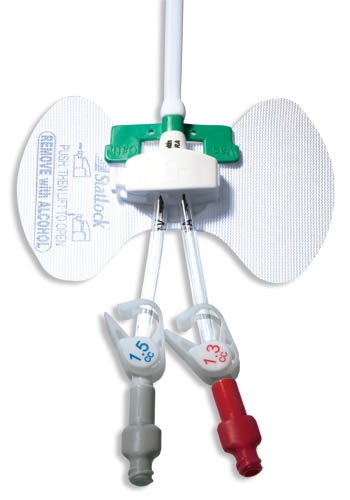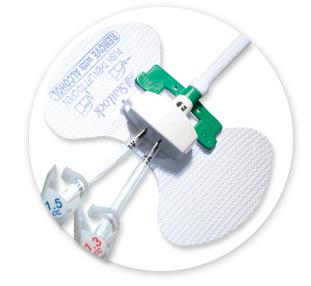- Features a releasable proprietary retainer with an integrated, adhesive core.
- Anchor pad is made of a breathable tricot polyester, absorbent hydrocolloid.
- Features skin safe, hypoallergenic, adhesive system.
Ready to learn more? Let’s have a conversation.
StatLock™ Dialysis Stabilization Device
The StatLock™ Dialysis Stabilization Device is designed to secure virtually all short-term hemodialysis catheters, thereby eliminating suture securement.


- Overview
- Products & Accessories
- EIFU & Resources
- FAQ
The StatLock™ Dialysis Stabilization Device is designed to secure virtually all short-term hemodialysis catheters, thereby eliminating suture securement.

Our collection of literature on industries and on our offerings gives you information you can use to continue striving for excellence.
Training resources to help improve your clinical practices as part of our goal of advancing the world of health.
We support the healthcare industry with market-leading products and services that aim to improve care while lowering costs. We host and take part in events that excel in advancing the world of health™.
We promote clinical excellence by providing various resources on best practices, clinical innovations and industry trends in healthcare.
- All
- For Patients
- For Providers
Nearly.The StatLock stabilization device is contraindicated in patients with known allergies to adhesives or tapes.
While the StatLock stabilization device is probably appropriate for more than 99% of your patients; some people have skin that simply will not accept an adhesive-based product – their skin is too flaky, too greasy, or too diaphoretic. Use clinical judgment. Just know that where you can use StatLock stabilization device, your clinical and cost outcomes will be dramatically improved.
You do need to extend your insertion site alcohol prep or chlorhexidine prep widely to both sides to cover the securement site. This is a necessary step to cleanse the skin before the StatLock stabilization device application.
BD recommends the use of the skin prep pad included with the StatLock stabilization device. The skin prep provides an acrylic layer that protects the skin and enhances adherence of the anchor pad. Performing both of these steps will maximize product performance.
When you use the skin prep you'll need to allow it to dry for 10 to 15 seconds and make certain it is dry, meaning smooth to the touch – not tacky. Use your clinical judgment based on assessment of the patient's skin. Just remember, when skin prep is not used the StatLock stabilization devices may prematurely lift.
Yes.
- Always orient the push-tab straight up.
- Always connect the StatLock stabilization retainer device to the PIV before placing the StatLock stabilization device onto skin.
- The blue StatLock stabilization device retainer clip is like an upside-down "V". Therefore, do not inadvertently squeeze it closed by compressing both sides. Instead, just hold one side and snap it over the hub of the catheter.
You can use them to:
- Stabilize the catheter while prepping and securing with the StatLock stabilization device by applying the foam strips over the catheter hub
- Fashion a J-loop with the IV tubing
- Form a cushion under your luer lock spin nut
- For extension sets without luer locks, wrap them around the catheter and the extension set connection for added security
- Reinforce the StatLock stabilization devices. They are sterile, tape is not.
If you had a tape-secured PIV, then you would have to remove the tape to change the tubing.
StatLock IV Ultra stabilization device
With the StatLock IV Ultra stabilization device you can keep the stabilization device in place while you change tubing. Simply steady the retainer with the thumb and index finger of one hand while unscrewing the extension set. Remove the set. Then, while continuing to brace the retainer, press-fit and screw in your replacement extension set.
StatLock IV Select stabilization device
For StatLock IV Select stabilization device, you will need to replace the StatLock stabilization devices when you remove and replace the tubing – just as you would with tape securement; but this is a rare event offset by StatLock stabilization device advantages.
<p>Nearly.The StatLock stabilization device is contraindicated in patients with known allergies to adhesives or tapes.</p> <p>While the StatLock stabilization device is probably appropriate for more than 99% of your patients; some people have skin that simply will not accept an adhesive-based product – their skin is too flaky, too greasy, or too diaphoretic. Use clinical judgment. Just know that where you can use StatLock stabilization device, your clinical and cost outcomes will be dramatically improved.</p>
<p>You do need to extend your insertion site alcohol prep or chlorhexidine prep widely to both sides to cover the securement site. This is a necessary step to cleanse the skin before the StatLock stabilization device application.</p> <p>BD recommends the use of the skin prep pad included with the StatLock stabilization device. The skin prep provides an acrylic layer that protects the skin and enhances adherence of the anchor pad. Performing both of these steps will maximize product performance.</p> <p>When you use the skin prep you'll need to allow it to dry for 10 to 15 seconds and make certain it is dry, meaning smooth to the touch – not tacky. Use your clinical judgment based on assessment of the patient's skin. Just remember, when skin prep is not used the StatLock stabilization devices may prematurely lift.</p>
<p>Yes.</p> <li>Always orient the push-tab straight up.</li> <li>Always connect the StatLock stabilization retainer device to the PIV before placing the StatLock stabilization device onto skin.</li> <li>The blue StatLock stabilization device retainer clip is like an upside-down "V". Therefore, do not inadvertently squeeze it closed by compressing both sides. Instead, just hold one side and snap it over the hub of the catheter.</li>
<p>You can use them to:</p> <li>Stabilize the catheter while prepping and securing with the StatLock stabilization device by applying the foam strips over the catheter hub</li> <li>Fashion a J-loop with the IV tubing</li> <li>Form a cushion under your luer lock spin nut</li> <li>For extension sets without luer locks, wrap them around the catheter and the extension set connection for added security</li> <li>Reinforce the StatLock stabilization devices. They are sterile, tape is not.</li>
<p>If you had a tape-secured PIV, then you would have to remove the tape to change the tubing.</p> <p><strong>StatLock IV Ultra stabilization device</strong></p> <p>With the StatLock IV Ultra stabilization device you can keep the stabilization device in place while you change tubing. Simply steady the retainer with the thumb and index finger of one hand while unscrewing the extension set. Remove the set. Then, while continuing to brace the retainer, press-fit and screw in your replacement extension set.</p> <p><strong>StatLock IV Select stabilization device</strong></p> <p>For StatLock IV Select stabilization device, you will need to replace the StatLock stabilization devices when you remove and replace the tubing – just as you would with tape securement; but this is a rare event offset by StatLock stabilization device advantages.</p>
BD-19919

